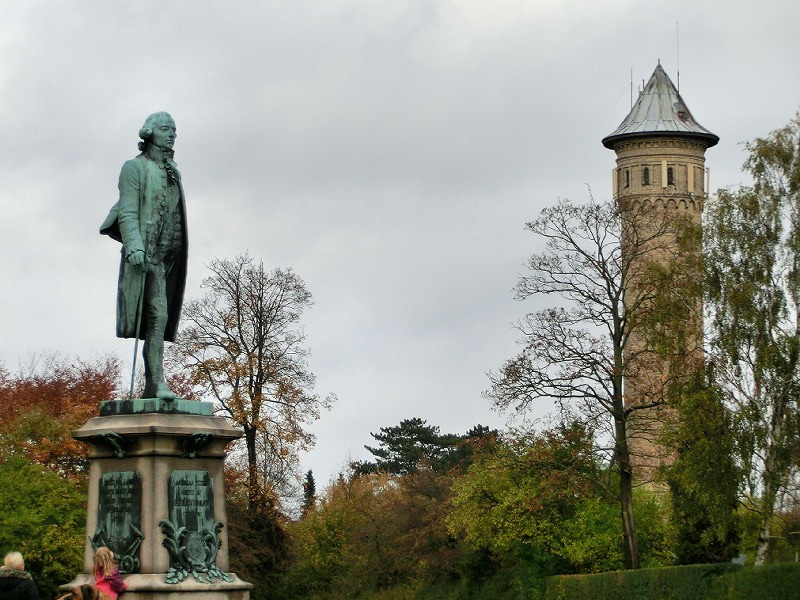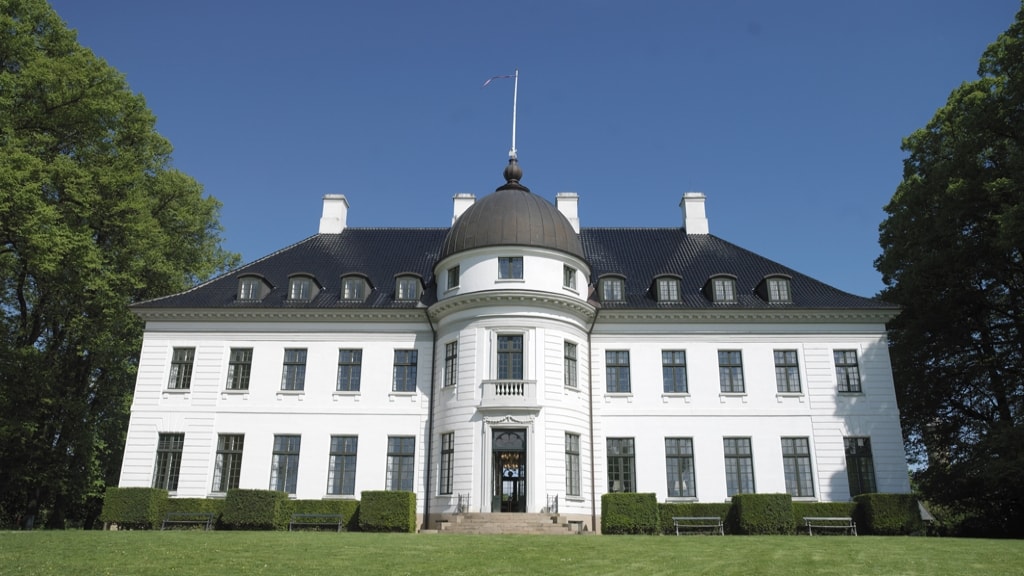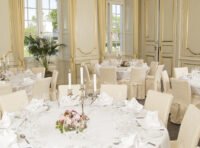
Description: Bernstorff Slot Standing in a fabulous Romantic landscaped park in the municipality of Gentofte, Bernstorff Slot is set in a magnificently restored historic palace, originally built in 1765 for the foreign minister of Denmark. Kort over Danmark. Opdag lokale forretninger, find venner og familie, se historiske luftfotos, gadefotos og meget mere.

The palace was designed by the French architect Nicolas-Henri Jardin, who had been brought to Denmark to complete Frederick's Church in Copenhagen after the death of Nicolai Eigtved in 1754. It is one of the earliest examples of Neoclassical architecture in Denmark. The elaborately decorated two-storeyed building was completed in May 1765 at considerable cost.[1] At the time, it had four small decorative garrets, attics with decorative vases and a wide balcony on the roof ridge itself. On the garden side, there is a dome-covered projection rising the full height of the building.[2]
The palace's many rooms were modest in size and intended primarily for domestic use rather than for display. Most are panelled with parquet floors, large mirrors and decorated ceilings. The four rooms on the south side have overdoors decorated by Johan Edvard Mandelberg.
Bernstorff left Denmark in 1770, after being dismissed by the regent, Johann Friedrich Struensee. The estate remained in his family's hands until 1812 but was then sold on several occasions. It was about to be demolished in 1842 when Christian VIII bought it and charged Jørgen Hansen Koch with its comprehensive renovation. A mezzanine was added and the layout of the first-floor rooms was changed.
Fitting Jardin's decorative style, Norwegian marble fireplaces are to be found in three of the larger rooms. A sign above the entrance reads: 'Honesto inter Labores otio sacrum' or 'Reserved for honest rest during periods of work.'
Recent history
Bernstorff Slot Add to my trip Bernstorff Palace is situated in the delightful surroundings of the palace, with high ceilings and the most wonderful view of Bernstorff Palace Garden. Bernstorff Palace (Danish: Bernstorff Slot) in Gentofte, Copenhagen, Denmark, was built in the middle of the 18th century for Foreign Minister Johann Hartwig Ernst von Bernstorff. It remained in the possession of the Bernstorff family until 1812. In 1842, it was bought by Christian VIII.
In 1854, Bernstorff Palace was placed at the disposal of Crown Prince Christian who adopted it as his preferred summer residence. Indeed, it was to become a popular retreat for the royal couple and their extended family during the king's long reign. Visitors included Tsar Alexander III of Russia and Edward VII of the United Kingdom. In 1888, after the Nordic Exhibition, Queen Louise bought the timbered Swedish pavilion and had it fitted out as guest quarters.
The fireplace is of Norwegian Gjellebekk marble, which also forms the pillars of Marble Church. A church that you can see on direct bird escape line on the horizon from Bernstorff Slots 1. Experience the many historical details on your next visit-www.bernstorffslot.dk 💙.
On Christian IX's death in 1906, Prince Valdemar of Denmark inherited the palace, continuing to use it as a summer residence until his death in 1939.
Since then and until very recently, it was used by the Danish Emergency Management Agency as an academy for non-commissioned officers. On 1 May 2009, after an agreement with Gitte Jensen and Kirsten Nielsen, Bernstorff Palace opened as a hotel and conference centre.[3][4]
The palace gardens
The palace's extensive gardens were laid out are in the Romantic landscape style which had just been introduced to Denmark in the 1760s. In addition to the lawns and woods, they include a rose garden, an orchard and a tea house.[5] It is believed that Jardin who designed the palace was also responsible for their design, especially as his plans refer to the emergence of landscape gardens as a new trend in Denmark.
The Bernstorffs who took great interest in the gardens, planted apricots, peaches, grapes, rare apple and pear trees, cherries and plums in their kitchen garden together with rare varieties of cucumbers, artichokes, lettuces and melons from France and the Netherlands. They acquired a host of rare trees and bushes for the gardens including chestnuts, acacias, holly, tulip trees, plane trees, medlars, azaleas, barberries, quinces and lilacs, many of them completely new to Denmark at the time.
Most of these exotic varieties had withered away by the time Christian IX bought the estate in 1854. He charged Rudolph Rothe, the royal garden inspector, to replace them with Danish oak and beech which can still be seen today.
The beautiful Swedish Villa in the gardens was built in 1888 in the classic Swedish timbered style in connection with the Nordic Exhibition. Run by the Swedish Villa Foundation, it is used for art exhibitions, concerts and as a café.[6]
See also
Related Research Articles
Gentofte Kommune is a municipality in the Capital Region of Denmark on the east coast of the island of Zealand (Sjælland) in eastern Denmark. It covers an area of 25.54 km2 (9.86 sq mi), and has a total population of 74,548. Since 1993, its mayor has been Hans Toft, a member of the Conservative People's Party.

Amalienborg is the home of the Danish royal family, and is located in Copenhagen, Denmark. It consists of four identical classical palace façades with rococo interiors around an octagonal courtyard ; in the centre of the square is a monumental equestrian statue of Amalienborg's founder, King Frederick V.
Christiansborg Palace is a palace and government building on the islet of Slotsholmen in central Copenhagen, Denmark. It is the seat of the Danish Parliament, the Danish Prime Minister's Office, and the Supreme Court of Denmark. Also, several parts of the palace are used by the Danish monarch, including the Royal Reception Rooms, the Palace Chapel and the Royal Stables.
Frederiksborg Castle is a palatial complex in Hillerød, Denmark. It was built as a royal residence for King Christian IV of Denmark-Norway in the early 17th century, replacing an older castle acquired by Frederick II and becoming the largest Renaissance residence in Scandinavia. Situated on three islets in the Slotssøen, it is adjoined by a large formal garden in the Baroque style.
Frederiksberg Palace is a Baroque residence, located in Frederiksberg, Denmark, adjacent to the Copenhagen Zoo. It commands an impressive view over Frederiksberg Gardens, originally designed as a palace garden in the Baroque style. Constructed and extended from 1699 to 1735, the palace served as the royal family’s summer residence until the mid-19th century. Since 1869, it has housed the Royal Danish Military Academy.
Frederiksberg Gardens is one of the largest and most attractive greenspaces in Copenhagen, Denmark. Together with the adjacent Søndermarken it forms a green area of 64 hectares at the western edge of Inner Copenhagen. It is a romantic landscape garden designed in the English style.

Prince Valdemar of Denmark was the third son and youngest child of Christian IX and Louise of Hesse-Kassel. He had a lifelong naval career.
Nicolas-Henri Jardin, neoclassical architect, was born in St. Germain des Noyers, Dept. Seine-et-Marne, France, and worked seventeen years in Denmark as an architect to the royal court. He introduced neoclassicism to Denmark.
Bernstorff Slotshave
Fredensborg Palace is a palace located on the eastern shore of Lake Esrum in Fredensborg on the island of Zealand (Sjælland) in Denmark. It is the Danish Royal Family’s spring and autumn residence, and is often the site of important state visits and events in the Royal Family. It is the most used of the Royal Family’s residences.
Charlottenlund Palace is a former royal summer residence in Charlottenlund, some 10 km north of central Copenhagen, Denmark. The palace was named after Princess Charlotte Amalie, who was responsible for the construction of the original palace. It was later extended and adapted for Crown Prince Frederick VIII to a design by Ferdinand Meldahl in the early 1880s.
Prince Axel Christian Georg of Denmark, was a Danish prince and a grandson of Christian IX of Denmark On his father's side, he was a first cousin of Christian X of Denmark, Haakon VII of Norway, Constantine I of Greece, George V of the United Kingdom, Nicholas II of Russia, Maud of Wales and Ernest Augustus III, Duke of Brunswick and on his mother's side of Henri, Count of Paris (1908–1999), Orleanist pretender to the French throne. Prince Axel was a popular patron of sports. He was a prominent International Olympic Committee member and activist and also a business executive. In 1963, Prince Axel became the first honorary member of the IOC in history. He was an officer in the Royal Danish Navy.

The architecture of Denmark has its origins in the Viking period, richly revealed by archaeological finds. It became firmly established in the Middle Ages when first Romanesque, then Gothic churches and cathedrals sprang up throughout the country. It was during this period that, in a country with little access to stone, brick became the construction material of choice, not just for churches but also for fortifications and castles.
The French formal garden, also called the jardin à la française, is a style of garden based on symmetry and the principle of imposing order on nature. Its epitome is generally considered to be the Gardens of Versailles designed during the 17th century by the landscape architect André Le Nôtre for Louis XIV and widely copied by other European courts.
Sorgenfri Palace is a royal residence of the Danish monarch, located in Lyngby-Taarbæk Municipality, on the east side of Lyngby Kongevej, in the northern suburbs of Copenhagen. The surrounding neighbourhood is called Sorgenfri after it. Only the cellar and foundations survive of the first Sorgenfri House, which was built in 1705 to design by François Dieussart. The current house was built in 1756 by Lauritz de Thurah and later adapted and extended by Peter Meyn in the 1790s. Lauritz de Thurah has also designed buildings which flank the driveway closer to the road.
Liselund is an 18th-century aesthetically landscaped park, complete with several exotic buildings and monuments. Located close to Møns Klint on the north-eastern corner of the Danish island of Møn, it is deemed to be one of the finest examples in Scandinavia of Romantic English gardening. The park was created in the 1790s by French nobleman Antoine de Bosc de la Calmette for his wife Elisabeth, commonly known as Lisa. Liselund, roughly translated, means Lise's grove.
Gudmund Nyeland Brandt was a Danish landscape architect who was internationally renowned.
Marienlyst Castle, Danish Marienlyst Slot, is a palacial residence located in Helsingør, Denmark. It was named after King Frederik V of Denmark's second wife, Juliana Maria the queen consort of Denmark and Norway. The building formerly served as a royal pavilion of Kronborg Castle and was mostly used as a venue for pleasure and hunting. It was also used by the director-general of the Øresund Custom House, Colonel Adam Gottlob von Krogh and his wife Magdalene, between 1796 and 1847.
Amaliegade is a street in central Copenhagen, Denmark, which makes up the longer of the two axes on which the Rococo district Frederiksstaden is centred. Amaliegade extends from Sankt Annæ Plads to Esplanaden, passing through the central plaza of Amalienborg Palace on the way where it intersects Frederiksgade, the other, shorter but more prominent, axis of the district.
The Yellow Palace, or Bergum's Mansion, is an 18th-century town mansion situated at Amaliegade 18, next to Amalienborg Palace, in the Frederiksstaden district of Copenhagen, Denmark. It is considered the first example of Neoclassical architecture in Copenhagen.
Hægersborg Allé is a major street in the Charlottenlund and Jægersborg neighborhoods of Gentofte Municipality in the northern suburbs of Copenhagen, Denmark. It runs from Strandvejen in the southeast to a junction just east of Kægersborg station in the northwest. The first leg of the road passes through Charlottenlund Forest, and it later follows the north boundary of Bernstorff Park. It passes a number of historic buildings, including Charlottenlund Palace, Bernstorff Palace and Schæffergården.
Bernstorff Slot Julemarked 2020
References
- ↑ Bernstorffs Slot from Palaces and Properties Agency.Archived February 19, 2012, at the Wayback Machine Retrieved 23 January 2010.
- ↑ Bernstorff Slot - Neoclassical architectureArchived May 16, 2011, at the Wayback Machine. Retrieved 23 January 2010.
- ↑ Bernstorff Slot. From Danish Conference Centres. Retrieved 23 January 2010.
- ↑ Nutidige konferencer & møder i historiske omgivelser. From Bernstorffs Slot.Archived October 25, 2009, at the Wayback Machine In Danish. Retrieved 23 January 2010.
- ↑ Bernstorff Palace Gardens.Archived October 26, 2013, at the Wayback Machine Retrieved 22 July 2013.
- ↑ Svenske Villa i Bernstoffparken. From Gentofte kommuneArchived April 27, 2009, at the Wayback Machine. In Danish. Retrieved 24 January 2010.
Bernstorff Slot
External links
| Wikimedia Commons has media related to Bernstorff Slot. |
Coordinates: 55°45′30″N12°33′08″E / 55.7584°N 12.5523°E
Bernstorff Slot Brunch
Text is available under the CC BY-SA 4.0 license; additional terms may apply.
Images, videos and audio are available under their respective licenses.